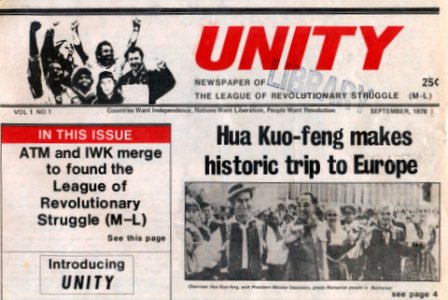
First Published: Unity, Vol. 1, No. 1, September 1978.
Transcription, Editing and Markup: Paul Saba
Copyright: This work is in the Public Domain under the Creative Commons Common Deed. You can freely copy, distribute and display this work; as well as make derivative and commercial works. Please credit the Encyclopedia of Anti-Revisionism On-Line as your source, include the url to this work, and note any of the transcribers, editors & proofreaders above.
Unity will strive to build from the work and experiences of Getting Together and the Revolutionary Cause newspapers, which were the political organs of I Wor Kuen and the August Twenty-ninth Movement (M-L).
Getting Together and the Revolutionary Cause were both distributed nationally and contributed to disseminating Marxism-Leninism and raising the political consciousness of the masses. Both built a network around their work, and both were bi-lingual – Getting Together published in English and Chinese, while the Revolutionary Cause published in English and Spanish.
Getting Together was the organ of IWK since late 1969, and was in constant publication except for a period of summation from 1975-1976. Getting Togetherís greatest strength was its consistent revolutionary stand and Marxist-Leninist line on many major questions, which enabled the paper to educate many people and to give guidance to the work of many revolutionaries for nine years.
Getting Together played a consistent leading role in providing a correct analysis of the international situation and the proletarian internationalist tasks of the people of the U.S.; in promoting support for socialist China; in upholding Chairman Mao’s three worlds analysis; in upholding the importance of the national question in the U.S.; and in giving leadership to many workers’ and anti-imperialist struggles.
While Getting Together had many strengths, there were also weaknesses and errors. Especially in its early period, there was a lack of articles dealing with questions being discussed in the communist movement. This weakness stemmed from IWK’s error of belittling the importance of waging an active ideological struggle in the Marxist-Leninist movement. There were also weaknesses of narrowness in the scope of the paper, and it did not expand its coverage rapidly enough during this period to take up the broad range of issues facing the working class as a whole.
Particularly since May 1976, Getting Together struggled to correct these weaknesses and developed from a newspaper concentrated primarily in the Asian-American national movements and distributed in a handful of cities to a Marxist-Leninist newspaper with writers, financial sustainers, distributors, and discussion groups all over the country. It developed a broader scope of coverage, struggled to overcome weaknesses of amateurishness, and developed further as an important organizing tool for a number of mass campaigns. Although there was still a need for more analytical articles and articles addressing more of the questions facing the communist movement, the paper made great progress in these areas. On the whole, Getting Together expanded and improved qualitatively in the recent period.
The Revolutionary Cause began publication in 1975, as the political organ of ATM. It always tried to address the important questions facing the communist movement and contributed to developing a Marxist-Leninist line and understanding of labor and trade union work, of the national question and on the international situation. The Revolutionary Cause consistently covered struggles of the working class, of the national movements and of all the just struggles of the countries, nations and peoples of the world.
Weaknesses in the Revolutionary Cause generally reflected weaknesses in the development of ATM. When ATM had a “left” deviation in party building which counterposed theoretical tasks to the tasks of building communist ties among the masses, the Revolutionary Cause tended to mainly carry long analytical articles and lacked a wide variety of topical political exposures.
ATM’s struggle for a more correct view of communist newspaper work became one of the main struggles that led ATM to break from the “Revolutionary Wing” in early 1976.
After breaking with the “Revolutionary Wing,” ATM summed up its errors and struggled to correct them. In the recent period, there has been a rapid and qualitative development of the content, style and distribution of the newspaper. The scope of the paper broadened to include more nationwide news and exposures, and a good combination of propaganda and agitational articles. There was a steady growth in the network being built around the newspaper.
Overall, the Revolutionary Cause has made contributions to the development of a Marxist-Leninist line for the U.S. revolution and helped to propagate revolutionary ideas among the masses.
* * *
Unity brings together many valuable lessons from the publication of Getting Together and the Revolutionary Cause over the past years. Unity hopes to learn from the shortcomings and errors and build upon the strengths of this work.